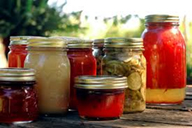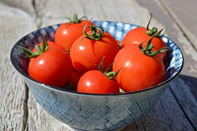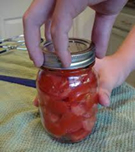 | Know what is safe to water bath can! Water bath canning is only safe for highly acidic foods or foods that you are adding acid to, for example, lemon juice or vinegar. Products that can be preserved using water bath include: jams and jellies, fruits, applesauce and pickles. |
 | What about tomatoes? Tomatoes can be safely canned using a water bath ONLY if an acid such as lemon juice or vinegar is added. As tomatoes have evolved over the last several decades, they have become less and less naturally acidic. Look for a tested recipe when canning tomatoes to ensure the acidity is high enough to create a safe product. If you dislike the addition of lemon juice or vinegar, opt for pressure canning. |
 | What do I need for water bath canning? You can purchase an official “water bath canner”, but you don’t need to invest in one if you already have the right equipment. Any large stock pot can be used for canning as long as it meets the following criteria: 1. Must have a well-fitting lid. 2. Must have a removable jar rack at the bottom. You can purchase these separately if it is all you need. And 3. Must be deep enough so that at least one inch of water covers the tops of the jars. |
 | Headspace. When filling your jars, it is important to be aware of how much headspace you are leaving at the top. The headspace is the amount of empty space between the top of the jar and where the food is filled to. This allows for expansion during the canning process. For water bath products, you should always leave 1/2” headspace in each jar. |
 | Removing air bubbles. Using either a bubble freer, a butter knife or small spatula, you will need to gently remove any bubbles from inside your jar. This allows trapped oxygen to escape from the jar. If too much oxygen remains in the jar after processing, it can change the headspace level, resulting in fruit or pickles left sticking out of the preserving liquid, which over time will leave them dried out, discolored, and less flavorful. |
 | Fingertip tight! This is a very important phrase in the canning world. When placing the screw bands on your jars for processing, you only want them about “fingertip tight”, meaning that you can easily unscrew them with just a light fingertip touch. If you tighten the lids too much, they can buckle over the jar during processing and then cannot be removed. Remember, the screw band is only used to keep the lid in place. The lid is what seals and keeps the food preserved. |
Privacy Overview
This website uses cookies so that we can provide you with the best user experience possible. Cookie information is stored in your browser and performs functions such as recognising you when you return to our website and helping our team to understand which sections of the website you find most interesting and useful.


